smokinghole
Member
Here's my first try at making the 360 herringbone pattern. Turns out it is as hard as it looks.
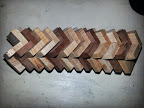
Here's what it looks like on the mandrel.
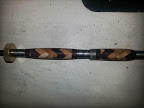
The problem is, to my everlasting shame, I am apparently not able to create dozens of perfectly square, 3/16" thick segments. I have several voids in the final product.
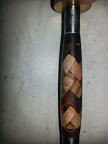
The method I used was to create several 3/4" square blanks about 12" long. I then put some painters tape on my bandsaw table with a line indicating how think to cut them.
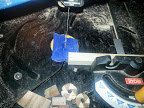
Because my bandsaw doesn't leave very smooth cuts, I re-squared the ends of my blank after each piece was cut off using my disk sander / lathe jig.
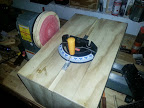
After cutting a few dozen squares of each color (walnut, crabapple, crabapple sapwood) I assembled the blank as described in several tutorials.
I think the problem is that my squares were not perfectly even thickness because of the inaccuracy inherent in both my crappy bandsaw and the technique of eyeballing the line on the painter's tape. I was thinking about trying it again, but this time planing my pieces down to 3/16" and then cutting the squares off of that.
Has anybody had better luck with these than I have? Which method did you use?

Here's what it looks like on the mandrel.

The problem is, to my everlasting shame, I am apparently not able to create dozens of perfectly square, 3/16" thick segments. I have several voids in the final product.

The method I used was to create several 3/4" square blanks about 12" long. I then put some painters tape on my bandsaw table with a line indicating how think to cut them.

Because my bandsaw doesn't leave very smooth cuts, I re-squared the ends of my blank after each piece was cut off using my disk sander / lathe jig.

After cutting a few dozen squares of each color (walnut, crabapple, crabapple sapwood) I assembled the blank as described in several tutorials.
I think the problem is that my squares were not perfectly even thickness because of the inaccuracy inherent in both my crappy bandsaw and the technique of eyeballing the line on the painter's tape. I was thinking about trying it again, but this time planing my pieces down to 3/16" and then cutting the squares off of that.
Has anybody had better luck with these than I have? Which method did you use?
